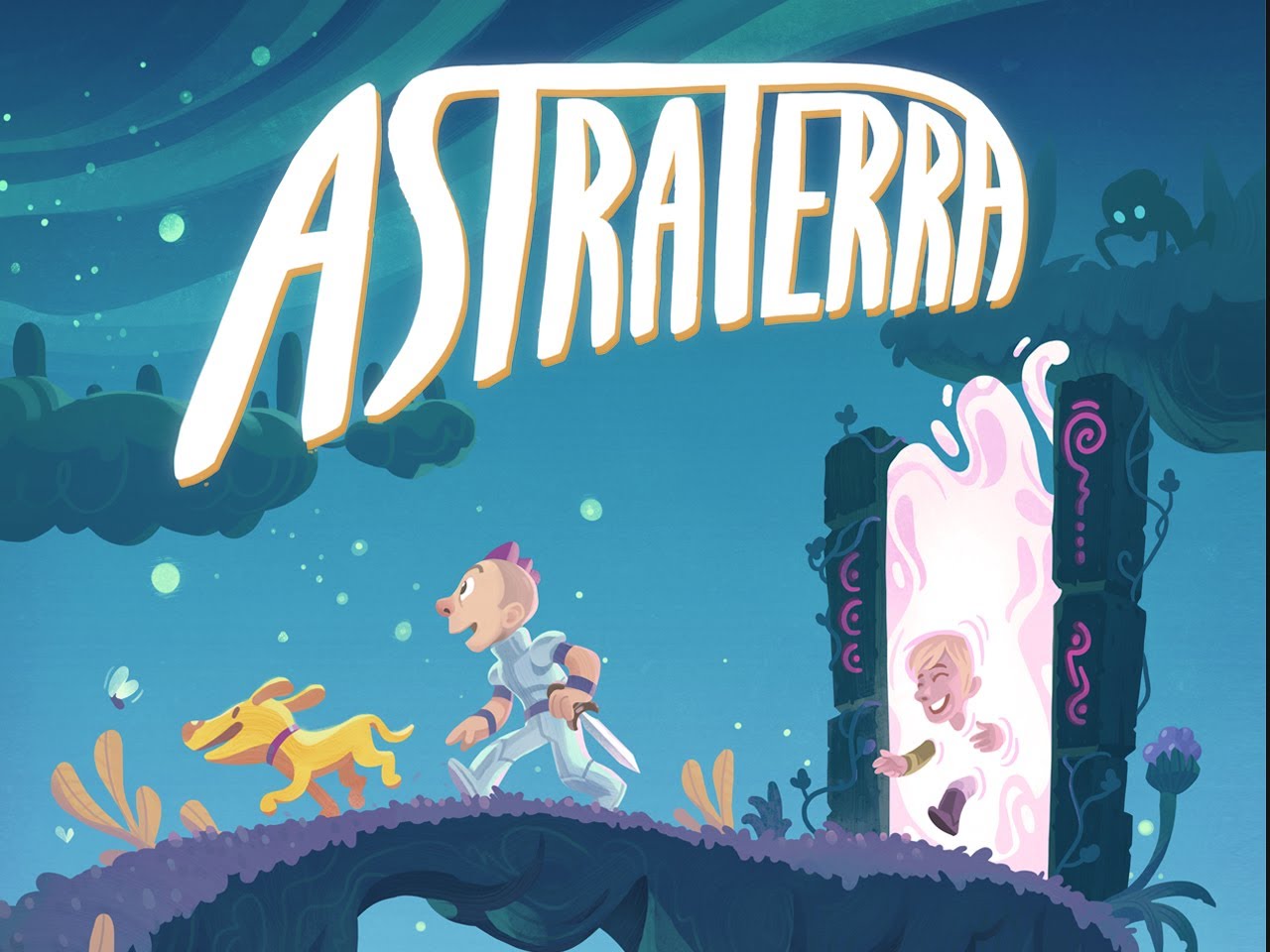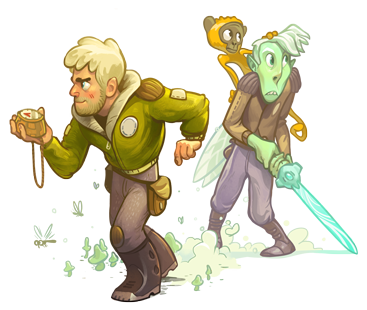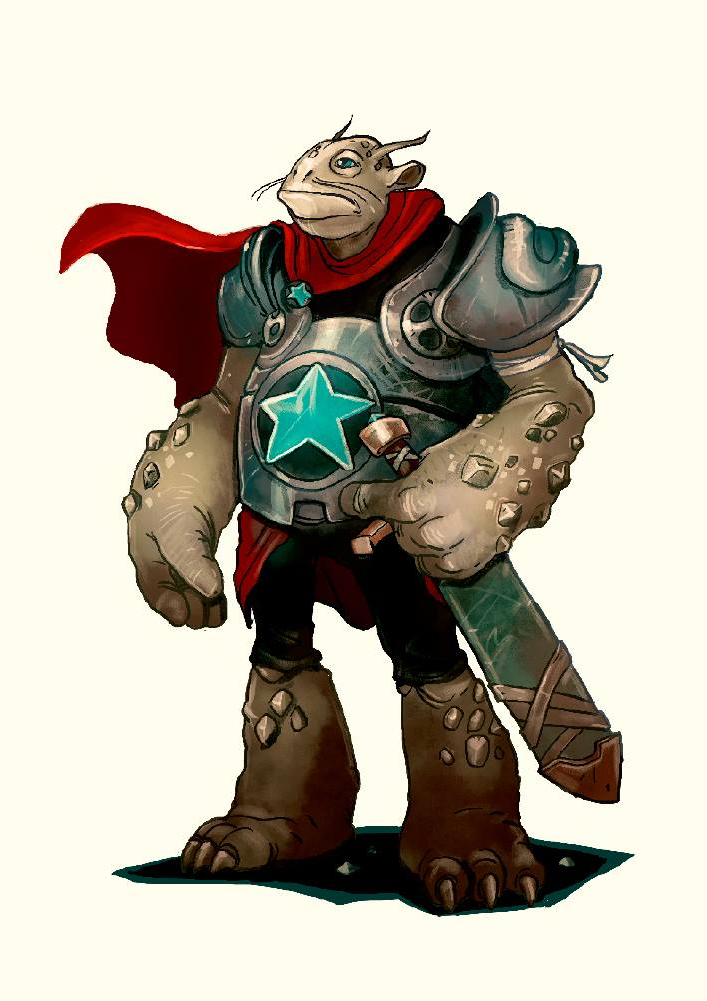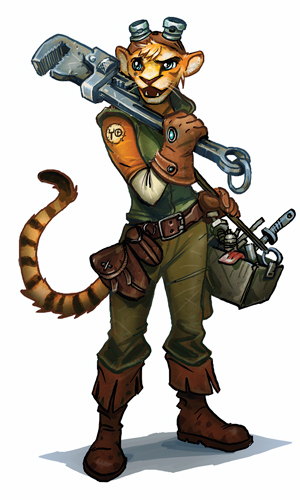Astraterra by Ratpick
| 1 | Intro |
| 2 | Making Heroes |
Intro
Original SA postOkay, so I was supposed to do a write-up of
The Secret of Zir'An
, but I've decided against it. Because I only own the physical edition of the book and don't have access to a scanner, my review would be very sparse on the art, and there's no way I'm buying the PDF of the game at the price it's going for. Also, there's not much I would've gotten out of the game besides what was already discussed in this thread: it's the perfect example of an early aughts heartbreaker with an insistence on making up its own vocabulary, a system with some interesting quirks but ultimately nothing to write home about, and a setting that is full of great ideas but sadly not fleshed out very much.
Thankfully, I just picked up the perfect game for doing a write-up on this weekend:
Astraterra
.

A bit of history: Astraterra is a Finnish role-playing game specifically aimed at kids who are new to role-playing games. Originally crowdfunded in June 2014 the game was released in Ropecon (the biggest Finnish RPG convention) that very same year in July. The game is currently available only in Finnish, but an English translation is to be released during this very year!
Speaking of the English translation, since I'm going from the Finnish edition I'll be pretty much translating all the vocabulary and concepts of the game. Since the translation process of the game is still ongoing, I have absolutely no way of knowing whether the translations I have to offer will in any way match the decisions made by the game's translators.
Before I get into the actual review, here's a quick overview: Astraterra is very clearly in the science fantasy genre. There's no actual magic in the game's setting, but the technological wonders of the setting (as well as the technologies left behind by the Ancients) serve the purpose of magic in the game's setting. The setting is essentially a world destroyed in a cataclysm a long time ago, the floating remnants of the world orbiting a whirling vortex in the center of the world.

Oh, hey, they have the English map available on their website already!
Travel between the floating islands is conducted either through airships (because of course) or teleportals, which are exactly what it says on the tin: the teleportals are gates made by the highly technologically advanced Ancients that in the old days formed a network for travel. While some of the teleportals are in active use, a number remain inactive, the means to activating them unknown and their destinations a mystery. The heroes (the game's term for PC) of the game are explorers, sent to investigate what mysteries lie behind the inactive teleportals.

By the way, the thing that sold me on this game was definitely the art. Just look at it!
So, Astraterra is much more about exploration than beating people up, and while the game does have rules for combat character death doesn't happen at zero HP (called Guts in Astraterra) but instead your character loses their nerve and runs away or goes and hides behind a corner. The same also applies to the heroes fighting monsters: dropping a monster to zero Guts does not mean that you've killed the monster, it might mean that you've forced the monster to retreat or go into hiding, or maybe made them faint. Great care is taken by the game to make sure that combat isn't deadly and graphic.
As far as the system goes, Astraterra only makes use of good old six-sided dice in a system that is actually shades of the system used by Burning Wheel, Mouse Guard and Torchbearer: that is, you have a dice pool equal to your skill, any roll of 1, 2 or 3 is a failure (or a "dud" as the game calls them; another way in which the game is similar to the aforementioned games, as it even has its own vocabulary for failures), while a 4, 5 or a 6 is a success. However, a minor difference from the above is that sixes always explode in Astraterra, giving you a success but also allowing you to roll another die to see if you get another success, which in the aforementioned games is only something that happens under some special circumstances. Also, for dice pools of size five or higher the player is allowed to convert dice to automatic successes at a price of 1 success per two dice.
So, you roll, compare your number of successes to the obstacle of the roll, if you exceed the obstacle you succeed! This is pretty much the basic mechanic of the game, but it is expanded upon in some of the other rules of the game.
Next time I'll begin my look at Astraterra in earnest with a look at character creation. It's very simple, quick and stream-lined, as befits an RPG meant mostly at kids.
Making Heroes
Original SA post Astraterra
Part 2: Making Heroes
Okay, so the second part of my writeup of Astraterra, a Finnish children's adventure RPG, has been a long time coming, but I'm finally getting to it.
Because Astraterra is primarily meant for kids, you'd expect character creation to be pretty easy. You'd be right. The chapter walks you through character creation in ten easy steps.
Also, at this point I must point out one of the most beautiful ideas the game's designers had: there are pre-filled character sheets available for Astraterra. The most important steps of character creation in Astraterra are choosing your Species and choosing your Role . The pre-filled character sheets include a number of sheets for each Species and a number for each Role, meaning that in order to create your character you simply pick a single Species sheet, a single Role sheet (which both have all of your Species and Role features written in) and then make a few choices and bam, you're done!
First step of creating a hero is choosing your hero's Species . Your Species determines your starting number of dice in each of the game's 6 Skills, which are Agility, Dexterity (yes, the game distinguishes between the two: Agility is about being quick on your feet, good for characters who want to do a lot of parkour and jumping around, whereas Dexterity is for precise hand-eye coordination, being useful for using guns and working mechanical devices), Poise (the Charisma equivalent), Strength, Awareness, and Intelligence, as well as giving you a single special feature. Each Species also has a list of appropriate names to help you in naming your hero.

A human and a solar.
Humans are, as per RPG tradition, presented as the baseline. They have 2 dice in all of their Skills, and as their racial feature they're Gutsy , getting +1 to their Guts ability (Astraterra's hitpoints).

A caven starknight.
Cavens are short stocky creatures from the Iron Islands who in spite of having extremely big hands and thick fingers are extremely dexterous and capable of making really precise machinery. They look a bit like short humanoid turtles with a rocky texture to their skin, and as they age the males sometimes develop catfish-like whiskers on their face. They have 3 dice in Dexterity and Strength, but only 1 in Agility and Awareness. Their Species feature, Handyman , gives them an extra die whenever they are doing something related to crafts, mechanics or alchemy.

A chimera mechanic.
Chimeras are an extremely versatile species of humanoid animals. There are as many different Chimeras as there are animals, and the book even mentions that while most of them fall on the cat and dog person axis, there are Chimeras as strange as satyrs and minotaurs on the Isles of Fantasia and the Arkadian Dynasties. Chimeras have 3 dice in Awareness but only 1 in Dexterity owing to their lack of technical skills. Their Species feature, Keen Senses , gives them an extra die on any roll where their heightened senses of hearing and smell might be of use.
Solars are lithe winged people. Basically, they're flying space elves. They have 3 dice in Agility but only 1 in Strength, and their Species feature is Wings , with which they can fly in the weightless heights of the star sea. In areas of normal gravity they can't fly, but their wings still allow them to glide safely down great heights and jump really far. In mechanical terms, they get an extra die on all rolls involving jumping and trying to fall safely.
Having chosen our Species we then move on to choosing our Role . Each Role gives the character three Traits as well as a selection of equipment.
Daredevils are exactly what you'd expect: they do crazy parkour, they run into danger without thinking, and they're at their best when doing crazy stunts. Their three Traits are Parkour (an extra die on all feats of jumping, climbing, balancing, and running), Evasive Manouver (an extra die on defending while Dodging. It's worth noting that Dodging and Blocking work slightly differently in Astraterra.) and Trick Driver (an extra die on operating all kinds of vehicles as well as mounts). For their equipment they get a sword, safety goggles, a ten meter rope and a grappling hook, and traveling gear. In addition to this they get to choose two of the following: a whip, a blaster pistol, a spyglass, leather armor, and a pet.
Mechanics are experts at fixing things and taking apart things. Their Traits are Fixing (an extra die on fixing things), Wrecking (an extra die on breaking things apart), and Machine Use (an extra die when trying to use a gadget, gizmo, technological artifact, apparatus, vehicle, or any other piece of machinery). For their equipment they get a multi-purpose wrench (multi-purpose indeed, as it also serves as a weapon), 1d6 repair kits, safety goggles, and traveling gear. They also get a choice of two from the following: a small circular saw, a toolkit, lockpicks, a jack , and a pet.
Doctors are not, as you might expect, medical professionals. Well, okay, they're that too, but they're more like Indiana Jones styled adventure academics. Their Traits are Sciencing (an extra die on anything related to the sciences and booksmartness), Healing (an extra die on first aid, healing sicknesses and curing poison, as well as identifying different medicines and herbs), and Ancestor Lore (an extra die on all rolls involving the Ancestors, the mythical precursors of Astraterra's current civilization. This applies equally to trying to decipher the language of the Ancestors as well as trying to use techno-treasures.). For their equipment they get an encyclopedia on a subject of their choice, a pole (yes, it's a ten-foot pole), an apparatus (the exact nature of which is determined by rolling on a chart), and traveling gear. Again, they get to choose two more pieces of gear from a list: a portable laboratory, a medical bag, a teleport compass (shows the direction to the nearest teleport), a looking glass, and a pet.
So, Doctors all get an apparatus, rolling 1d6 on a chart. The possibilities are as follows:
1. Scentilator - An apparatus that looks somewhat like a gas mask with a long snout at the end. It amplifies the user's sense of smell, giving them an extra die on all rolls involving their sense of smell.
2. Multivisioners - A pair of glasses with lots of different easily switchable lenses. Gives an extra die on all rolls involving sight, including working with really tiny objects (because it lets you see them more closely) or seeing really far away.
3. Metal Detector - Yeah, it's an extra die on finding metal objects.
4. Life-o-Meter - Basically a magic stethoscope. Gives an extra die on identifying illnesses and poisons affecting patients, as well as healing their injuries.
5. Sound-b-Gone - A belt that mutes sound. Gives an extra die on sneaking.
6. Translatophone - This piece of headgear gives an extra die on trying to understand foreign languages, whether written or spoken, as well as trying to speak them.
Finally, we get to the last of the Roles, the Starknight . Starknights are traveling warriors who have protected the people of Astraterra since the dawn of time. In addition to protecting the innocent, they also act as diplomats and councilors for the nobility. Hmmm, that seems oddly familiar. Anyway, their Traits are Battle Skill (an extra die on melee combat as well as blocking, whether with or without weapons), Weapon Master (an extra die when using blasters, bows and other projectile or thrown weapons), and Negotiation (an extra die on rolls for trying to negotiate and mediate, provided one is trying to build peace and compromise. So, no using this for selfish goals or tricking people). Starknights start with a sword, leather armor, traveling gear, and a star crest (basically a symbol of their authority), and two of the following: shield, large sword, short bow, blaster pistol, and a pet.
After you've chosen your hero's Species and Role you choose their Aptitude , namely which Skill your character excels at. You add one die to that Skill. After that you only need to figure out your Guts (Strength+Poise), roll to see what kind of a pet you get if you chose one, determine your hero's personality, distinctive features, and name, and bam, you're done!
Next time I'll be skipping ahead a bit (because I'm sure you won't mind me skipping the section dissecting the game's six stats and what you can do with each of them) and go into how the game's rules actually work.